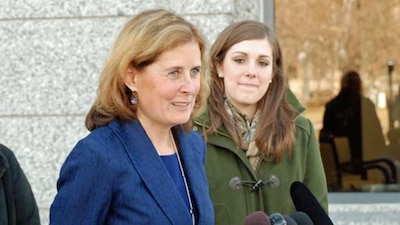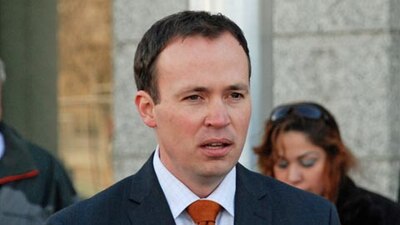Debate over what makes a constitutionally adequate education dominated the Lobato v. State oral arguments before the Colorado Supreme Court on Thursday morning.

The high court is considering the state’s appeal of the 2011 ruling by a Denver district judge that the state’s school funding system isn’t “rationally related” to the state constitution’s requirement for a “thorough and uniform” public education system.
Potentially at stake in the case are billions of dollars in education spending and the shape of the state’s K-12 system.
The three lawyers who spoke faced the challenge of squeezing into 60 minutes the evidence, arguments and legal intricacies of a case that has stretched over eight years, took five weeks at trial and has produced hundreds of thousands of documents.
And the justices’ questions cut into the lawyers’ time.
The historic session drew a full crowd to the court’s new chambers in the Ralph Carr Judicial Center, and listeners spilled into two overflow rooms where the proceedings were broadcast live.
Many of the observers were looking for hints of the justices’ leanings in the questions they asked of lawyers Jonathan Fero, representing the state, and Terry Miller, representing the plaintiff parents and school districts. David Hinojosa of the Mexican American Legal Defense and Education Fund, who represents a separate group of clients, also spoke to the court.
One important fact about the case was revealed when the justices walked onto the bench and Justice Monica Marquez was not in the group.
Chief Justice Michael Bender then announced that Marquez would not be participating in the case. Appointed to the high court in 2010, Marquez worked on earlier parts of the Lobato case as an assistant attorney general, and there has been speculation about whether she would participate. That leaves an even number of justices – six – to decide one of the most important public policy cases in decades, creating the possibility of a tie on the court. In that case the district court decision would stand.
What the lawyers said
Fero, an assistant attorney general, repeatedly argued that having a thorough and uniform educational system doesn’t mean creating a system where every child is equally successful.
Yet that’s what Denver District Judge Sheila Rappaport concluded in her December 2011 decision – that “if any students aren’t making it the whole system is irrational,” Fero said.
“Universal achievement cannot be what the constitution requires,” he added.
Fero also repeated a central state argument, that if the court defines the meaning of “thorough and uniform” it will be stepping on the legislature’s authority and violating the separation of powers among branches of government.
Fero called the current finance structure “a very well thought-out system.”
Miller, one of the many volunteer lawyers on the plaintiffs’ legal team, argued that the question of the court’s role was settled in 2009, when the high court resurrected the original Lobato lawsuit and ruled it could be heard in district court.
“At the end of the day it’s this court that decides what a thorough and uniform system looks like. … Just declare a broken system unconstitutional and let the legislature do its job” to come up with a new system, Miller said.
Both he and Hinojosa disagreed that they want a “perfect” system or that Rappaport ordered the creation of one.
What the justices asked
Five of the six justices questioned the lawyers, with Chief Justice Michael Bender and Justice Gregory Hobbs taking the lead.
Hobbs seemed the most sympathetic to the plaintiffs.
Referring to the legislature, Hobbs said, “They’re setting all these [education] requirements and not backing it up” with funding.
“I’m very concerned that the state’s argument here is we don’t have any duty and should give up” trying to improve the system.
Bender noted that the court routinely rules on constitutional questions and asked Fero whether this case “different from other constitutional matters.”
The chief justice also asked if the state disagreed with the facts uncovered at trial about graduation rates, test scores and other achievement issues.
“We’re not challenging any of the factual findings, just the conclusions of law,” Fero said.
Justice Nathan Coats asked Fero about the state’s definition of “thorough and uniform education.”
“I don’t have a very helpful answer,” Fero said, adding that those three words are “extremely bare” in the constitution as to their meaning.

Bender asked Miller about “the balance between the role of the court and the role of the legislature.”
Miller replied, “Give the legislature the chance to do its job” and come up with “some rational determination of the cost” of standards-based education.
Bender asked how much time that might take.
“The legislature has a wide array of tools to use including time,” Miller said. “It doesn’t have to happen in one year.”
The only justice to ask no questions was Brian Boatright, who wasn’t on the court when it first considered the Lobato case in 2009 and voted 4-3 to revive it. (Two of the justices who voted on the prevailing side have since left the court.)
After the arguments wrapped up, Bender praised the “very lengthy, very articulate briefs. We have a lot of advice.”
What’s next
The Supreme Court has no deadline to rule in the case. Kathleen Gebhardt, lead attorney for the plaintiffs, told EdNews, “I’m hoping for three or four months.” The court has a variety of options ranging from upholding Rappaport’s ruling to sending the case back to her for further deliberations.
